ICN Lung Ultrasound Case 6
Download as pptx, pdf2 likes1,240 views
The lung ultrasound found bright, confluent B lines and sub-pleural abnormalities in the right lung, which can indicate a more chronic condition. No significant effusion was seen. The left lung was normal with no abnormalities detected.
1 of 8
Downloaded 22 times
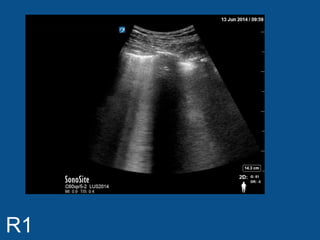
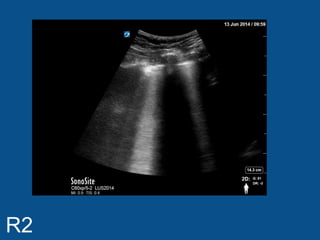
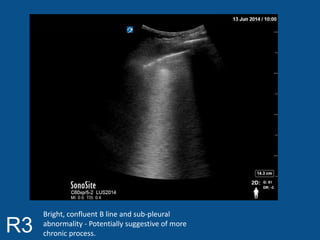

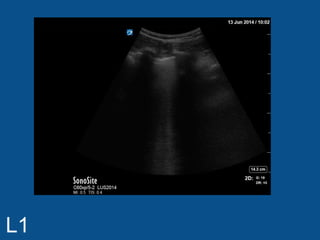


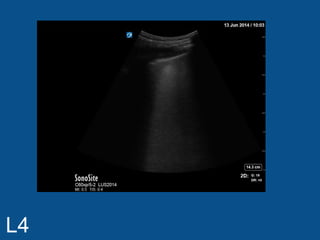
Ad
Recommended
Lung Ultrasound - Case 3
Lung Ultrasound - Case 3ICNUploads
Ěý
The document discusses lung scans and CT scans that were taken in different positions. Lung scans were taken erect while CT scans were supine. One scan showed strongly positive confluent B lines in the posterior lung with an indistinct edge that would not move higher when the depth was at 15cm.ICN Lung Ultrasound Case 5
ICN Lung Ultrasound Case 5ICNUploads
Ěý
The document discusses a chest x-ray of a patient lying down. A small fluid buildup was detected, prompting the doctor to have the patient roll over to check the back of the lungs more closely. Upon further investigation, a small fluid buildup was again seen acting as an indicator to look more deeply.ICN Lung Ultrasound Case 10
ICN Lung Ultrasound Case 10ICNUploads
Ěý
This chest x-ray report notes small abnormalities in the lungs that prompted further investigation with additional views. A small pleural effusion acted as a signal to look deeper for other issues. Two small pleural line abnormalities in the lower areas of the lungs give a high probability of a pulmonary embolism, as one wedge-shaped opacity is most typical of a small pulmonary embolism.ICN Lung Ultrasound Case 8
ICN Lung Ultrasound Case 8ICNUploads
Ěý
The document notes an abnormality in the right lung, with 8cm of chest wall overlying the thoracic cage at its most shallow point, as well as minimal collapse just above the diaphragm. No abnormalities are mentioned for the left lung.Lung Ultrasound Case 1
Lung Ultrasound Case 1ICNUploads
Ěý
The ultrasound scan showed a small nodule on the pleural edge near the ribs and cardiac shadow, indicating the probe was close to the midline with part of the heart visible to the right. No other abnormalities were seen on the scan.Mile High Anaesthesia by Healy
Mile High Anaesthesia by HealySMACC Conference
Ěý
The document discusses various aspects of anaesthesia, particularly prehospital rapid sequence intubation (RSI) and its associated safety concerns. It emphasizes the importance of timely patient care and the impact of delays in transportation to hospital care. The document also briefly touches on topics like PTSD and anaesthetic awareness in the context of major trauma.Anaesthesia Outside O.R.
Anaesthesia Outside O.R.Shailendra Veerarajapura
Ěý
The document discusses anesthesia techniques for procedures outside the operating room in various clinical settings. It outlines the challenges of providing anesthesia outside the OR including lack of adequate space, unfamiliar equipment, and difficulties in patient positioning and monitoring. It then provides details on anesthesia considerations and plans for specific procedures in cardiology, psychiatry, plastic surgery, and radiology departments. These include techniques for angiography, electroconvulsive therapy, burn dressings, CT scans, MRI scans, and radiation therapy. Monitoring standards, equipment needs, and drug choices are discussed for safely providing anesthesia for each type of external procedure.Signs in Lung Ultrasound
Signs in Lung UltrasoundICNUploads
Ěý
Basic summary of the common signs in lung ultrasound - Kylie BakerAnaesthesia outside operating room
Anaesthesia outside operating roomnarasimha reddy
Ěý
This document discusses anesthesia and sedation procedures performed outside the operating room. It outlines common procedures that require anesthesia outside OR settings like radiology suites and ICUs. It also describes the challenges anesthesiologists face in these settings like unfamiliar environments, limited equipment and monitoring, and patient issues. Guidelines are provided for sedation versus general anesthesia based on the procedure and safety standards for monitoring, equipment, and discharge criteria when anesthesia is provided outside the traditional operating room.The Basics of Lung Ultrasound
The Basics of Lung UltrasoundICNUploads
Ěý
Ultrasound is a useful screening tool for the lungs but has limitations. An 8-view ultrasound exam of the lungs can detect extravascular lung water seen as B lines originating from the pleural line. While a normal exam has evenly spaced A lines, more than 2 B lines in any view outside the lung bases indicates abnormality. Ultrasound has good sensitivity and specificity for detecting diffuse lung abnormalities compared to chest x-ray, but can miss localized findings and has a 15% error rate in certain conditions like fibrosis or resolving illnesses.Anesthesia outside the operating room
Anesthesia outside the operating roomSumit Prajapati
Ěý
Anesthesia is increasingly being provided outside of operating rooms for various medical procedures. This presents unique challenges including limited workspace, outdated equipment, and less familiarity with patient management. Guidelines from organizations like the American Society of Anesthesiologists aim to improve safety for procedures requiring anesthesia outside the operating room, such as for imaging like CT, MRI, and interventional radiology procedures. Close monitoring and careful consideration of each patient's needs, procedure requirements, and equipment limitations are important for ensuring good outcomes during non-operating room anesthesia.NON OPERATING ROOM ANAESTHESIA
NON OPERATING ROOM ANAESTHESIAUnnikrishnan Prathapadas
Ěý
This document discusses anesthesia considerations for procedures performed outside the operating room. It notes that the number and complexity of such procedures has increased, bringing additional responsibilities for anesthesiologists. Special challenges include limited space, equipment, and support staff unfamiliar with patient management. Proper equipment, monitoring, and planning are important when providing anesthesia or sedation in remote locations. The document discusses various locations like radiology suites, specific procedures like ECT, and choices of anesthetic agents and techniques. Patient safety is the top priority for remote location anesthesia.Coarse Dispersion, Physical Pharmaceutics
Coarse Dispersion, Physical Pharmaceuticsnishiprakashj
Ěý
Its a compilation of unit 3 as per PCI syllabus of B.Pharm IV sem, Subject Physical Pharmaceutics.ELECTROMYOGRAPHY.pptX by GOKULAKRISHNAN.
ELECTROMYOGRAPHY.pptX by GOKULAKRISHNAN.GOKULAKRISHNAN JANARTHANAN
Ěý
Electromyography is basically the study of motor unit activity.
In electromyography, the study of the electrical activity of contracting muscle provides information concerning the structure and function of the motor units.
ANATOMY OF LARYNX -Prof.Dr.N.Mugunthan, KMMC.pdf
ANATOMY OF LARYNX -Prof.Dr.N.Mugunthan, KMMC.pdfKanyakumari Medical Mission Research Center, Muttom
Ěý
Anatomy of the Larynx
Larynx is a cartilaginous structure located in the **anterior neck** at the level of **C3–C6 vertebrae**.
* Also called the **voice box**—responsible for **phonation**, **airway protection**, and **breathing regulation**.
**Cartilages of the Larynx**
**Unpaired Cartilages:**
1. **Thyroid cartilage**:
* Largest cartilage; forms the **Adam’s apple (laryngeal prominence)**.
* Composed of two laminae that fuse anteriorly.
2. **Cricoid cartilage**:
* Ring-shaped; **only complete ring** around the airway.
* Located below thyroid cartilage; articulates with thyroid & arytenoid cartilages.
3. **Epiglottis**:
* Leaf-shaped elastic cartilage.
* Covers the laryngeal inlet during swallowing.
**Paired Cartilages:**
1. **Arytenoid**:
* Pyramid-shaped; sit on top of cricoid.
* Attach vocal cords and muscles.
2. **Corniculate**:
* Small cartilages sitting atop the arytenoids.
3. **Cuneiform**:
* Embedded in the aryepiglottic folds; provide structural support.
**Intrinsic Muscles of the Larynx**
> Responsible for controlling **vocal cord movement**.
| Muscle | Action | Nerve Supply |
| **Cricothyroid** | Tenses vocal cords | External laryngeal nerve |
| **Thyroarytenoid** | Relaxes vocal cords | Recurrent laryngeal nerve |
| **Posterior cricoarytenoid** | Abducts vocal cords (opens glottis) | Recurrent laryngeal nerve |
| **Lateral cricoarytenoid** | Adducts vocal cords | Recurrent laryngeal nerve |
| **Transverse & oblique arytenoids** | Closes the posterior glottis | Recurrent laryngeal nerve |
| **Vocalis** | Fine-tunes pitch | Recurrent laryngeal nerve | **Nerve Supply*
* **Motor**:
* All intrinsic muscles (except cricothyroid): **Recurrent laryngeal nerve** (branch of vagus nerve).
* Cricothyroid: **External branch of superior laryngeal nerve**.
* **Sensory**:
* Above vocal cords: **Internal branch of superior laryngeal nerve**.
* Below vocal cords: **Recurrent laryngeal nerve**.
**Blood Supply**
* **Superior laryngeal artery** (branch of superior thyroid artery).
* **Inferior laryngeal artery** (branch of inferior thyroid artery).
**Laryngeal Cavity & Folds**
Divided into 3 regions:
1. **Vestibule** – from inlet to vestibular folds (false cords).
2. **Ventricle** – between vestibular and vocal folds.
3. **Infraglottic cavity** – below vocal cords to trachea.
**Vocal folds (true cords)** – involved in sound production.Clinical Signs Overview: PICCKLE Mnemonic
Clinical Signs Overview: PICCKLE MnemonicDr Aman Suresh Tharayil
Ěý
This presentation provides a concise yet comprehensive review of common clinical signs and their diagnostic significance, summarized under the acronym PICCKLE – Pallor, Icterus, Clubbing, Cyanosis, Koilonychia, Lymphadenopathy, and Edema. Each condition is defined, followed by key causes, pathophysiology, diagnostic techniques, and clinical relevance. The content is tailored for undergraduate and postgraduate students in medicine and pharmacy, as well as early-career clinicians seeking to reinforce their clinical examination skillsAn interesting case of facial Swelling in an autoimmune rheumatic disease Ahm...
An interesting case of facial Swelling in an autoimmune rheumatic disease Ahm...Internal medicine department, faculty of Medicine Beni-Suef University Egypt
Ěý
An interesting case of facial Swelling in an autoimmune rheumatic disease Ahmed Yehia EGYSIR Conference Alzheimer’s Disease Neuroradiology Case Conference: Mastering the New Frontie...
Alzheimer’s Disease Neuroradiology Case Conference: Mastering the New Frontie...PVI, PeerView Institute for Medical Education
Ěý
Co-Chairs, Gloria Chiang, MD, and Ana M. Franceschi, MD, PhD, discuss Alzheimer’s disease in this CME/AAPA activity titled “Alzheimer’s Disease Neuroradiology Case Conference: Mastering the New Frontier in Diagnosis and Treatment.” For the full presentation, downloadable Practice Aids, and complete CME/AAPA information, and to apply for credit, please visit us at https://bit.ly/43CE1XA. CME/AAPA credit will be available until July 3, 2026.From Wheals to Wellness: Transforming Chronic Spontaneous Urticaria Care With...
From Wheals to Wellness: Transforming Chronic Spontaneous Urticaria Care With...PVI, PeerView Institute for Medical Education
Ěý
Chair, Michael E. Manning, MD, FAAAAI, FACAAI, discusses chronic spontaneous urticaria in this CME activity titled “From Wheals to Wellness: Transforming Chronic Spontaneous Urticaria Care With Emerging Solutions.” For the full presentation, downloadable Practice Aids, and complete CME information, and to apply for credit, please visit us at . CME credit will be available until June 11, 2026.Tonsil anatomy, diseases and treatment options
Tonsil anatomy, diseases and treatment optionsManu Babu
Ěý
a brief decription of tonsil related pathologyWinning GAMBITS Against AML: Guidance on Advances & Medical Breakthroughs wit...
Winning GAMBITS Against AML: Guidance on Advances & Medical Breakthroughs wit...PVI, PeerView Institute for Medical Education
Ěý
Chair and Presenter, Naval Daver, MD, Jessica K. Altman, MD, and Ghayas Issa, MD, Alice S. Mims, MD, MSCR, discuss acute myeloid leukemia in this CME/MOC/AAPA/IPCE activity titled “Winning GAMBITS Against AML: Guidance on Advances & Medical Breakthroughs with Innovative Targeted Strategies.” For the full presentation, downloadable Practice Aids, and complete CME/MOC/AAPA/IPCE information, and to apply for credit, please visit us at https://bit.ly/42f1QCa. CME/MOC/AAPA/IPCE credit will be available until June 30, 2026.RCC Treatment Innovations in Practice: Preparing for Individualized Patient Care
RCC Treatment Innovations in Practice: Preparing for Individualized Patient CarePVI, PeerView Institute for Medical Education
Ěý
Chair, Sumanta Kumar Pal, MD, FASCO, David F. McDermott, MD, and Tian Zhang, MD, MHS, prepared useful Practice Aids pertaining to renal cell carcinoma for this CME/MOC/AAPA/IPCE activity titled “RCC Treatment Innovations in Practice: Preparing for Individualized Patient Care.” For the full presentation, downloadable Practice Aids, and complete CME/MOC/AAPA/IPCE information, and to apply for credit, please visit us at https://bit.ly/4brGF4h. CME/MOC/AAPA/IPCE credit will be available until June 30, 2026.Drug use in Peptic Ulcer_A complete review.pptx
Drug use in Peptic Ulcer_A complete review.pptxBaasir Umair Khattak
Ěý
Open PPT for detail description: Peptic Ulcer Disease (PUD)
Peptic ulcer disease refers to mucosal erosions equal to or greater than 5 mm in the stomach or proximal duodenum, caused primarily by an imbalance between gastric acid/pepsin secretion and mucosal defense mechanisms. The most common etiologies include Helicobacter pylori infection, chronic use of NSAIDs, and physiological stress.
Classification of Peptic Ulcers
🔹 Based on Location
Gastric Ulcers – Occur in the stomach lining.
Duodenal Ulcers – Occur in the first part of the small intestine (duodenum).
🔹 Based on Etiology
H. pylori–Associated Ulcers
NSAID-Induced Ulcers
Stress-Related Mucosal Disease (SRMD)
Zollinger–Ellison Syndrome (gastrinoma-related)
Cushing’s Ulcer (due to intracranial injury)
Curling’s Ulcer (seen in burn patients)
Pharmacological Management
🔹 1. Acid Suppression Therapy
Class Examples Mechanism
Proton Pump Inhibitors (PPIs) Omeprazole, Pantoprazole Irreversibly inhibit H+/K+ ATPase pump
H2-Receptor Antagonists Ranitidine, Famotidine Block histamine-mediated gastric acid secretion
🔹 2. Mucosal Protective Agents
Class Examples Mechanism
Prostaglandin Analogues Misoprostol Increases mucus & bicarbonate; decreases acid; protects mucosa
Mucosal Coating Agents Sucralfate Forms protective barrier over ulcer site
Bismuth Compounds Bismuth subsalicylate Antimicrobial, mucosal protective, and anti-inflammatory
🔹 3. Eradication Therapy (for H. pylori)
Combination of:
PPI + Two Antibiotics (e.g., amoxicillin + clarithromycin OR metronidazole + tetracycline)
Duration: 7–14 days depending on local guidelines
See BNF regimens above for detailed protocols
🔹 4. Cytoprotective/Adjunctive Agents
Class Examples Role in PUD
Somatostatin Analogues Octreotide Used in bleeding ulcers; reduces splanchnic blood flow and gastric secretions
Antacids Magnesium hydroxide, Aluminium hydroxide Neutralize gastric acid; provide symptomatic relief
Non-Pharmacologic Measures
Avoid NSAIDs, smoking, alcohol, and spicy foods
Small, frequent meals in symptomatic patients
Stress reduction
Endoscopic therapy in case of bleeding or perforation
Surgical Indications (rarely needed)
Perforated ulcer
Gastric outlet obstruction
Refractory ulcers not responding to medical therapy
Severe bleeding unresponsive to endoscopic management
âś… Summary
Peptic ulcer disease is primarily driven by H. pylori infection and NSAID use, with duodenal ulcers more common than gastric. Treatment is tailored based on etiology and includes acid suppression, H. pylori eradication, and mucosal protection. Advanced cases may require somatostatin analogues for hemorrhage control or surgery for complications. Prostaglandin analogues like misoprostol are especially valuable in preventing NSAID-induced ulcers.OUR SRS SBRT EXPERIENCE BY DR KANHU CHARAN PATRO
OUR SRS SBRT EXPERIENCE BY DR KANHU CHARAN PATROKanhu Charan
Ěý
OUR SRS SBRT EXPERIENCE BY DR KANHU CHARAN PATROINTERPRETATION OF LABORATORY INVESTIGATIONS.pptx
INTERPRETATION OF LABORATORY INVESTIGATIONS.pptxEliLawluvi
Ěý
THE DOCUMENT SUMMARIZES THE KEY COMPONENTS OF INTERPRETING FULL BLOOD CUNTPatient-Centric Frameworks in Desmoid Tumors: Integrating Emerging Science on...
Patient-Centric Frameworks in Desmoid Tumors: Integrating Emerging Science on...PVI, PeerView Institute for Medical Education
Ěý
Co-Chairs, Prof. Dr. Patrick Schöffski, MPH, and Breelyn A. Wilky, MD, discuss desmoid tumors in this CME activity titled “Patient-Centric Frameworks in Desmoid Tumors: Integrating Emerging Science on Gamma Secretase Inhibitors for Progressive Disease.” For the full presentation, downloadable Practice Aids, and complete CME information, and to apply for credit, please visit us at https://bit.ly/4iDPUQY. CME credit will be available until June 29, 2026.HEALTH CARE PLANNING AND ORGANIZATION OF HEALTH CARE
HEALTH CARE PLANNING AND ORGANIZATION OF HEALTH CAREnawaabaquib
Ěý
This PowerPoint presentation covers Unit II: Health Care Planning and Organization of Health Care at Various Levels in a simple and easy-to-understand format. It explains importance of health planning in India. The PPT also includes the structure of the health care system at central, state, and local levels. It is useful for GNM ,BSc And Msc Nursing students. This presentation is also helpful for exam preparation .More Related Content
Viewers also liked (6)
Anaesthesia Outside O.R.
Anaesthesia Outside O.R.Shailendra Veerarajapura
Ěý
The document discusses anesthesia techniques for procedures outside the operating room in various clinical settings. It outlines the challenges of providing anesthesia outside the OR including lack of adequate space, unfamiliar equipment, and difficulties in patient positioning and monitoring. It then provides details on anesthesia considerations and plans for specific procedures in cardiology, psychiatry, plastic surgery, and radiology departments. These include techniques for angiography, electroconvulsive therapy, burn dressings, CT scans, MRI scans, and radiation therapy. Monitoring standards, equipment needs, and drug choices are discussed for safely providing anesthesia for each type of external procedure.Signs in Lung Ultrasound
Signs in Lung UltrasoundICNUploads
Ěý
Basic summary of the common signs in lung ultrasound - Kylie BakerAnaesthesia outside operating room
Anaesthesia outside operating roomnarasimha reddy
Ěý
This document discusses anesthesia and sedation procedures performed outside the operating room. It outlines common procedures that require anesthesia outside OR settings like radiology suites and ICUs. It also describes the challenges anesthesiologists face in these settings like unfamiliar environments, limited equipment and monitoring, and patient issues. Guidelines are provided for sedation versus general anesthesia based on the procedure and safety standards for monitoring, equipment, and discharge criteria when anesthesia is provided outside the traditional operating room.The Basics of Lung Ultrasound
The Basics of Lung UltrasoundICNUploads
Ěý
Ultrasound is a useful screening tool for the lungs but has limitations. An 8-view ultrasound exam of the lungs can detect extravascular lung water seen as B lines originating from the pleural line. While a normal exam has evenly spaced A lines, more than 2 B lines in any view outside the lung bases indicates abnormality. Ultrasound has good sensitivity and specificity for detecting diffuse lung abnormalities compared to chest x-ray, but can miss localized findings and has a 15% error rate in certain conditions like fibrosis or resolving illnesses.Anesthesia outside the operating room
Anesthesia outside the operating roomSumit Prajapati
Ěý
Anesthesia is increasingly being provided outside of operating rooms for various medical procedures. This presents unique challenges including limited workspace, outdated equipment, and less familiarity with patient management. Guidelines from organizations like the American Society of Anesthesiologists aim to improve safety for procedures requiring anesthesia outside the operating room, such as for imaging like CT, MRI, and interventional radiology procedures. Close monitoring and careful consideration of each patient's needs, procedure requirements, and equipment limitations are important for ensuring good outcomes during non-operating room anesthesia.NON OPERATING ROOM ANAESTHESIA
NON OPERATING ROOM ANAESTHESIAUnnikrishnan Prathapadas
Ěý
This document discusses anesthesia considerations for procedures performed outside the operating room. It notes that the number and complexity of such procedures has increased, bringing additional responsibilities for anesthesiologists. Special challenges include limited space, equipment, and support staff unfamiliar with patient management. Proper equipment, monitoring, and planning are important when providing anesthesia or sedation in remote locations. The document discusses various locations like radiology suites, specific procedures like ECT, and choices of anesthetic agents and techniques. Patient safety is the top priority for remote location anesthesia.Recently uploaded (20)
Coarse Dispersion, Physical Pharmaceutics
Coarse Dispersion, Physical Pharmaceuticsnishiprakashj
Ěý
Its a compilation of unit 3 as per PCI syllabus of B.Pharm IV sem, Subject Physical Pharmaceutics.ELECTROMYOGRAPHY.pptX by GOKULAKRISHNAN.
ELECTROMYOGRAPHY.pptX by GOKULAKRISHNAN.GOKULAKRISHNAN JANARTHANAN
Ěý
Electromyography is basically the study of motor unit activity.
In electromyography, the study of the electrical activity of contracting muscle provides information concerning the structure and function of the motor units.
ANATOMY OF LARYNX -Prof.Dr.N.Mugunthan, KMMC.pdf
ANATOMY OF LARYNX -Prof.Dr.N.Mugunthan, KMMC.pdfKanyakumari Medical Mission Research Center, Muttom
Ěý
Anatomy of the Larynx
Larynx is a cartilaginous structure located in the **anterior neck** at the level of **C3–C6 vertebrae**.
* Also called the **voice box**—responsible for **phonation**, **airway protection**, and **breathing regulation**.
**Cartilages of the Larynx**
**Unpaired Cartilages:**
1. **Thyroid cartilage**:
* Largest cartilage; forms the **Adam’s apple (laryngeal prominence)**.
* Composed of two laminae that fuse anteriorly.
2. **Cricoid cartilage**:
* Ring-shaped; **only complete ring** around the airway.
* Located below thyroid cartilage; articulates with thyroid & arytenoid cartilages.
3. **Epiglottis**:
* Leaf-shaped elastic cartilage.
* Covers the laryngeal inlet during swallowing.
**Paired Cartilages:**
1. **Arytenoid**:
* Pyramid-shaped; sit on top of cricoid.
* Attach vocal cords and muscles.
2. **Corniculate**:
* Small cartilages sitting atop the arytenoids.
3. **Cuneiform**:
* Embedded in the aryepiglottic folds; provide structural support.
**Intrinsic Muscles of the Larynx**
> Responsible for controlling **vocal cord movement**.
| Muscle | Action | Nerve Supply |
| **Cricothyroid** | Tenses vocal cords | External laryngeal nerve |
| **Thyroarytenoid** | Relaxes vocal cords | Recurrent laryngeal nerve |
| **Posterior cricoarytenoid** | Abducts vocal cords (opens glottis) | Recurrent laryngeal nerve |
| **Lateral cricoarytenoid** | Adducts vocal cords | Recurrent laryngeal nerve |
| **Transverse & oblique arytenoids** | Closes the posterior glottis | Recurrent laryngeal nerve |
| **Vocalis** | Fine-tunes pitch | Recurrent laryngeal nerve | **Nerve Supply*
* **Motor**:
* All intrinsic muscles (except cricothyroid): **Recurrent laryngeal nerve** (branch of vagus nerve).
* Cricothyroid: **External branch of superior laryngeal nerve**.
* **Sensory**:
* Above vocal cords: **Internal branch of superior laryngeal nerve**.
* Below vocal cords: **Recurrent laryngeal nerve**.
**Blood Supply**
* **Superior laryngeal artery** (branch of superior thyroid artery).
* **Inferior laryngeal artery** (branch of inferior thyroid artery).
**Laryngeal Cavity & Folds**
Divided into 3 regions:
1. **Vestibule** – from inlet to vestibular folds (false cords).
2. **Ventricle** – between vestibular and vocal folds.
3. **Infraglottic cavity** – below vocal cords to trachea.
**Vocal folds (true cords)** – involved in sound production.Clinical Signs Overview: PICCKLE Mnemonic
Clinical Signs Overview: PICCKLE MnemonicDr Aman Suresh Tharayil
Ěý
This presentation provides a concise yet comprehensive review of common clinical signs and their diagnostic significance, summarized under the acronym PICCKLE – Pallor, Icterus, Clubbing, Cyanosis, Koilonychia, Lymphadenopathy, and Edema. Each condition is defined, followed by key causes, pathophysiology, diagnostic techniques, and clinical relevance. The content is tailored for undergraduate and postgraduate students in medicine and pharmacy, as well as early-career clinicians seeking to reinforce their clinical examination skillsAn interesting case of facial Swelling in an autoimmune rheumatic disease Ahm...
An interesting case of facial Swelling in an autoimmune rheumatic disease Ahm...Internal medicine department, faculty of Medicine Beni-Suef University Egypt
Ěý
An interesting case of facial Swelling in an autoimmune rheumatic disease Ahmed Yehia EGYSIR Conference Alzheimer’s Disease Neuroradiology Case Conference: Mastering the New Frontie...
Alzheimer’s Disease Neuroradiology Case Conference: Mastering the New Frontie...PVI, PeerView Institute for Medical Education
Ěý
Co-Chairs, Gloria Chiang, MD, and Ana M. Franceschi, MD, PhD, discuss Alzheimer’s disease in this CME/AAPA activity titled “Alzheimer’s Disease Neuroradiology Case Conference: Mastering the New Frontier in Diagnosis and Treatment.” For the full presentation, downloadable Practice Aids, and complete CME/AAPA information, and to apply for credit, please visit us at https://bit.ly/43CE1XA. CME/AAPA credit will be available until July 3, 2026.From Wheals to Wellness: Transforming Chronic Spontaneous Urticaria Care With...
From Wheals to Wellness: Transforming Chronic Spontaneous Urticaria Care With...PVI, PeerView Institute for Medical Education
Ěý
Chair, Michael E. Manning, MD, FAAAAI, FACAAI, discusses chronic spontaneous urticaria in this CME activity titled “From Wheals to Wellness: Transforming Chronic Spontaneous Urticaria Care With Emerging Solutions.” For the full presentation, downloadable Practice Aids, and complete CME information, and to apply for credit, please visit us at . CME credit will be available until June 11, 2026.Tonsil anatomy, diseases and treatment options
Tonsil anatomy, diseases and treatment optionsManu Babu
Ěý
a brief decription of tonsil related pathologyWinning GAMBITS Against AML: Guidance on Advances & Medical Breakthroughs wit...
Winning GAMBITS Against AML: Guidance on Advances & Medical Breakthroughs wit...PVI, PeerView Institute for Medical Education
Ěý
Chair and Presenter, Naval Daver, MD, Jessica K. Altman, MD, and Ghayas Issa, MD, Alice S. Mims, MD, MSCR, discuss acute myeloid leukemia in this CME/MOC/AAPA/IPCE activity titled “Winning GAMBITS Against AML: Guidance on Advances & Medical Breakthroughs with Innovative Targeted Strategies.” For the full presentation, downloadable Practice Aids, and complete CME/MOC/AAPA/IPCE information, and to apply for credit, please visit us at https://bit.ly/42f1QCa. CME/MOC/AAPA/IPCE credit will be available until June 30, 2026.RCC Treatment Innovations in Practice: Preparing for Individualized Patient Care
RCC Treatment Innovations in Practice: Preparing for Individualized Patient CarePVI, PeerView Institute for Medical Education
Ěý
Chair, Sumanta Kumar Pal, MD, FASCO, David F. McDermott, MD, and Tian Zhang, MD, MHS, prepared useful Practice Aids pertaining to renal cell carcinoma for this CME/MOC/AAPA/IPCE activity titled “RCC Treatment Innovations in Practice: Preparing for Individualized Patient Care.” For the full presentation, downloadable Practice Aids, and complete CME/MOC/AAPA/IPCE information, and to apply for credit, please visit us at https://bit.ly/4brGF4h. CME/MOC/AAPA/IPCE credit will be available until June 30, 2026.Drug use in Peptic Ulcer_A complete review.pptx
Drug use in Peptic Ulcer_A complete review.pptxBaasir Umair Khattak
Ěý
Open PPT for detail description: Peptic Ulcer Disease (PUD)
Peptic ulcer disease refers to mucosal erosions equal to or greater than 5 mm in the stomach or proximal duodenum, caused primarily by an imbalance between gastric acid/pepsin secretion and mucosal defense mechanisms. The most common etiologies include Helicobacter pylori infection, chronic use of NSAIDs, and physiological stress.
Classification of Peptic Ulcers
🔹 Based on Location
Gastric Ulcers – Occur in the stomach lining.
Duodenal Ulcers – Occur in the first part of the small intestine (duodenum).
🔹 Based on Etiology
H. pylori–Associated Ulcers
NSAID-Induced Ulcers
Stress-Related Mucosal Disease (SRMD)
Zollinger–Ellison Syndrome (gastrinoma-related)
Cushing’s Ulcer (due to intracranial injury)
Curling’s Ulcer (seen in burn patients)
Pharmacological Management
🔹 1. Acid Suppression Therapy
Class Examples Mechanism
Proton Pump Inhibitors (PPIs) Omeprazole, Pantoprazole Irreversibly inhibit H+/K+ ATPase pump
H2-Receptor Antagonists Ranitidine, Famotidine Block histamine-mediated gastric acid secretion
🔹 2. Mucosal Protective Agents
Class Examples Mechanism
Prostaglandin Analogues Misoprostol Increases mucus & bicarbonate; decreases acid; protects mucosa
Mucosal Coating Agents Sucralfate Forms protective barrier over ulcer site
Bismuth Compounds Bismuth subsalicylate Antimicrobial, mucosal protective, and anti-inflammatory
🔹 3. Eradication Therapy (for H. pylori)
Combination of:
PPI + Two Antibiotics (e.g., amoxicillin + clarithromycin OR metronidazole + tetracycline)
Duration: 7–14 days depending on local guidelines
See BNF regimens above for detailed protocols
🔹 4. Cytoprotective/Adjunctive Agents
Class Examples Role in PUD
Somatostatin Analogues Octreotide Used in bleeding ulcers; reduces splanchnic blood flow and gastric secretions
Antacids Magnesium hydroxide, Aluminium hydroxide Neutralize gastric acid; provide symptomatic relief
Non-Pharmacologic Measures
Avoid NSAIDs, smoking, alcohol, and spicy foods
Small, frequent meals in symptomatic patients
Stress reduction
Endoscopic therapy in case of bleeding or perforation
Surgical Indications (rarely needed)
Perforated ulcer
Gastric outlet obstruction
Refractory ulcers not responding to medical therapy
Severe bleeding unresponsive to endoscopic management
âś… Summary
Peptic ulcer disease is primarily driven by H. pylori infection and NSAID use, with duodenal ulcers more common than gastric. Treatment is tailored based on etiology and includes acid suppression, H. pylori eradication, and mucosal protection. Advanced cases may require somatostatin analogues for hemorrhage control or surgery for complications. Prostaglandin analogues like misoprostol are especially valuable in preventing NSAID-induced ulcers.OUR SRS SBRT EXPERIENCE BY DR KANHU CHARAN PATRO
OUR SRS SBRT EXPERIENCE BY DR KANHU CHARAN PATROKanhu Charan
Ěý
OUR SRS SBRT EXPERIENCE BY DR KANHU CHARAN PATROINTERPRETATION OF LABORATORY INVESTIGATIONS.pptx
INTERPRETATION OF LABORATORY INVESTIGATIONS.pptxEliLawluvi
Ěý
THE DOCUMENT SUMMARIZES THE KEY COMPONENTS OF INTERPRETING FULL BLOOD CUNTPatient-Centric Frameworks in Desmoid Tumors: Integrating Emerging Science on...
Patient-Centric Frameworks in Desmoid Tumors: Integrating Emerging Science on...PVI, PeerView Institute for Medical Education
Ěý
Co-Chairs, Prof. Dr. Patrick Schöffski, MPH, and Breelyn A. Wilky, MD, discuss desmoid tumors in this CME activity titled “Patient-Centric Frameworks in Desmoid Tumors: Integrating Emerging Science on Gamma Secretase Inhibitors for Progressive Disease.” For the full presentation, downloadable Practice Aids, and complete CME information, and to apply for credit, please visit us at https://bit.ly/4iDPUQY. CME credit will be available until June 29, 2026.HEALTH CARE PLANNING AND ORGANIZATION OF HEALTH CARE
HEALTH CARE PLANNING AND ORGANIZATION OF HEALTH CAREnawaabaquib
Ěý
This PowerPoint presentation covers Unit II: Health Care Planning and Organization of Health Care at Various Levels in a simple and easy-to-understand format. It explains importance of health planning in India. The PPT also includes the structure of the health care system at central, state, and local levels. It is useful for GNM ,BSc And Msc Nursing students. This presentation is also helpful for exam preparation .Irradiation to prevent TA-GvHD by Dr. Abrar Kabir Shishir.pptx
Irradiation to prevent TA-GvHD by Dr. Abrar Kabir Shishir.pptxAbrarKabir3
Ěý
This presentation discusses the role of irradiation in preventing transfusion-associated graft-versus-host disease (TA-GvHD). Covers pathophysiology, risk factors, investigation, prevention strategies, and irradiation procedures. Includes visuals and real-life context from Dhaka Medical College.Aspirin powder or Acetyl salicylic acid powder.docx
Aspirin powder or Acetyl salicylic acid powder.docxkopalsharma85
Ěý
pharmacy exercise on aspirin powderYoga Postures to Practice
for Holistic (Physical, Mental, and Cognitive) Well...
Yoga Postures to Practice
for Holistic (Physical, Mental, and Cognitive) Well...Bhoj Raj Singh
Ěý
An ancient System for holistic health (mental and physical) and wellbeing, is a scientific art of living with harmony (connecting) of mind and body. Although much more ancient than Patanjali, who documented yoga systematically about 2000 years ago, Patanjali is often referred to as the "father of modern yoga."
Yoga postures are commonly depicted in ancient paintings, carvings, and sculptures in almost all civilizations and religions, thus Yoga can’t be described as an act of Hinduism. It originated long before any religion on Earth, with the emergence of life on the Planet. All yoga poses are natural, and what is not natural is not yoga; it isĚýViyoga.
Besides Vedic Yoga, Hatha, Vinyasa, Ashtanga, Iyengar, Yin, Restorative, Kundalini, Bikram, Sahaj, and Power yoga are some popular types.
VinyasaĚýYoga is the closest form to Vedic Yoga; it is known for its flowing movements, not very rigorous, not too much straining, actions flow with the breath.
Though all yoga may lead to meditation (Dhyan) for your inner upliftment, it is not the same as described in Hinduism for self-liberation.
In Hinduism, different paths of life looking distinct but can be practiced all together, they are: Karma Yoga (selfless action and service), Bhakti Yoga (devotion and love for God or Godly power), Jnana (Gyan) Yoga (gaining knowledge for self-realization through wisdom), Dhyan Yoga (meditation) and Kriya Yoga (optimum utilization of your vital and muscular energy).Ěý
ANATOMY OF LARYNX -Prof.Dr.N.Mugunthan, KMMC.pdf
ANATOMY OF LARYNX -Prof.Dr.N.Mugunthan, KMMC.pdfKanyakumari Medical Mission Research Center, Muttom
Ěý
An interesting case of facial Swelling in an autoimmune rheumatic disease Ahm...
An interesting case of facial Swelling in an autoimmune rheumatic disease Ahm...Internal medicine department, faculty of Medicine Beni-Suef University Egypt
Ěý
Alzheimer’s Disease Neuroradiology Case Conference: Mastering the New Frontie...
Alzheimer’s Disease Neuroradiology Case Conference: Mastering the New Frontie...PVI, PeerView Institute for Medical Education
Ěý
From Wheals to Wellness: Transforming Chronic Spontaneous Urticaria Care With...
From Wheals to Wellness: Transforming Chronic Spontaneous Urticaria Care With...PVI, PeerView Institute for Medical Education
Ěý
Winning GAMBITS Against AML: Guidance on Advances & Medical Breakthroughs wit...
Winning GAMBITS Against AML: Guidance on Advances & Medical Breakthroughs wit...PVI, PeerView Institute for Medical Education
Ěý
RCC Treatment Innovations in Practice: Preparing for Individualized Patient Care
RCC Treatment Innovations in Practice: Preparing for Individualized Patient CarePVI, PeerView Institute for Medical Education
Ěý
Patient-Centric Frameworks in Desmoid Tumors: Integrating Emerging Science on...
Patient-Centric Frameworks in Desmoid Tumors: Integrating Emerging Science on...PVI, PeerView Institute for Medical Education
Ěý
Ad
ICN Lung Ultrasound Case 6
- 1. R1
- 2. R2
- 3. R3 Bright, confluent B line and sub-pleural abnormality - Potentially suggestive of more chronic process.
- 4. R4 No significant effusion
- 5. L1
- 6. L2
- 7. L3
- 8. L4